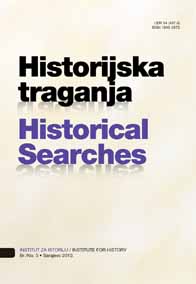Zadržati ime dinar - Pred izdavanje novih bosanskohercegovačkih novčanica
We Must Keep the Name Dinar - Before the issuing of new Banknotes in Bosnia and Herzegovina
Author(s): Boris NilevićSubject(s): History
Published by: Institut za istoriju
Keywords: Bosnia and Herzegovina; dinar; Stjepan II Kotromanić; Tvrtko; Ragusan republic
Summary/Abstract: In the Ordinance about the National bank (Official Gazette of Republic of Bosnia and Herzegovina, 1/93, article 41) it was stated that the monetary unit of the Republic of Bosnia and Herzegovina is the dinar. The continuity of use of the word dinar in Bosnia and Herzegovina can be followed through two thousand years. The Roman coin denarius (denarius, denarnovac) was used at the end of the 1st century BC. Under this name it was also called in Venice and the Ragusan Republic (denarius or grossus), and in Serbia (oldserb dinar). This was also the case in medieval Bosnia. The developed mining industry in medieval Bosnia encouraged the minting of domestic currency. The first Bosnian ruler who minted coins was Ban Stjepan II Kotromanić (1322-1353). His coins visually imitated the Venetian, Ragusan and Serbian emissions, which were at that time used in the Bosnian state. Tvrtko I (1353-1391) continued issuing coins which were typologically similar to the ones minted by his predecessor, but from 1365 he minted coins with new moulds he obtained from Ragusa. After the death of King Tvrtko I comes a long period during which the Bosnian rulers ceased to issue domestic currency, and this practice was ended by Tvrtko II Kotromanić. Domestic coins were minted in Bosnia up until the Ottoman conquest in 1463.
Journal: Historijska traganja
- Issue Year: 2010
- Issue No: 05
- Page Range: 127-129
- Page Count: 3
- Language: Bosnian

